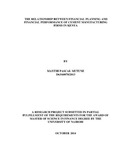| dc.description.abstract | The study analyzed the relationship between financial planning and financial
performance of cement manufacturing firms in Kenya. A census approach was used to
study the relationship in all the six cement manufacturing firms in Kenya. The instrument
of data collection was a semi-structured questionnaire having both open and close-ended
questions. Data on the financial performance was gathered from past records and audited
financial statements of the manufacturing firms. Secondary data was collected from
audited financial statements of all the cement manufacturing firms in Kenya for the years
in consideration. The study covered a five year period. Data was analyzed to establish the
measures of central tendency that include the mean, mode, and median highlighting the
key findings. Inferential statistics was used to establish the relationship between the
variables of the study and qualitatively by content analysis. Analysis of variance
(ANOVA) was used to determine the significant relationship, if any, of the variables. The
study used regression analysis to determine the extent to which financial planning
practices affects the financial performance of cement manufacturing firms. Findings of
the study overwhelmingly support the hypothesis that financial planning practices play a
big role in implementing most organizational policies. The failure of a firm to implement
financial planning activities and business planning activities seemed to inhibit many of
the cement manufacturing firms from making expected profits. Results also revealed that
financial planning activities, business planning activities and frequency of financial
planning techniques are the key factors that influence how well the company will perform
in the industry. Factors like risk management practices, employee turnover, tax planning,
contingency plans, monitoring the lead time, preserving excess stocks, monitoring stock
levels, avoiding stock out costs, setting profits target periodically and minimizing holding
costs came out to significantly influence the financial performance of a firm | en_US |

